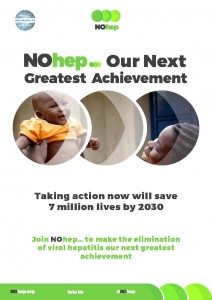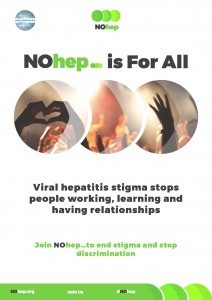 By Christine Kukka
By Christine Kukka
The World Health Organization has designated July 28 as World Hepatitis Day, a day to work for global change to eliminate viral hepatitis and the suffering, death and discrimination that accompanies hepatitis B and C by 2030.
From Asia to North America, on this day people around the world raise awareness about viral hepatitis and advocate for better access to treatment and prevention programs and more effective government action. Why? Because 4,000 deaths a day from viral hepatitis is 4,000 deaths too many.
This action is critical, because for too long global leaders have made hepatitis a low priority. Viral hepatitis is a silent disease that causes no symptoms until it’s too late, and many believed the hepatitis B vaccine would simply make the infection go away.
Instead, global health organizations focused on other diseases such as HIV/AIDS, tuberculosis and malaria. HIV especially benefited from unprecedented efforts and donated resources to enable diagnosis and prevention of transmission and to provide treatment at low cost.
Today, we need the same effort and resources to eradicate viral hepatitis, which kill an estimated 1.4 million each year – more people die from hepatitis annually than from HIV/AIDS and tuberculosis combined.
 For example, between 5 to 20 percent of the 1 billion people living in Sub-Saharan Africa have chronic hepatitis B Despite this prevalence, there are no widespread screening, education or prevention programs in Africa. The majority of people lucky enough to get screened and diagnosed for hepatitis B are often blood donors, because there are no public health clinics that provide screening for viral hepatitis.
For example, between 5 to 20 percent of the 1 billion people living in Sub-Saharan Africa have chronic hepatitis B Despite this prevalence, there are no widespread screening, education or prevention programs in Africa. The majority of people lucky enough to get screened and diagnosed for hepatitis B are often blood donors, because there are no public health clinics that provide screening for viral hepatitis.
In Asia and Africa, even when pregnant women are diagnosed with hepatitis B, their newborns are often not given that critical, first vaccine dose within 12 hours of birth that would break the mother-to-child hepatitis B infection cycle. The birth dose of the hepatitis B vaccine is either too costly or simply unavailable. Perinatal infection, though preventable, continues to be a major source of chronic infection worldwide.Around the world, discrimination against people with hepatitis B persists. Many countries prohibit immigration and education or professional advancement to people with hepatitis B. Some are considered “unmarriageable” if they are infected.
Even in the United States, people with hepatitis B cannot enlist or attend prestigious military academies if they have hepatitis B, even though they pose no health threat to fellow students and soldiers who are all required to be vaccinated against hepatitis B.
Despite the hepatitis B vaccine and a new “cure” for hepatitis C, in rural regions of the U.S., these two blood-borne liver infections are suddenly increasing due to unsafe injections resulting from the opiod epidemic.
We still have a long way to go. This year, advocates are taking a bold step to fight for the elimination of hepatitis B and C by 2030 through the NOhep campaign. Its ambitious goals include:
- Connecting and mobilizing people across the world who share the common goal of eliminating viral hepatitis
- Lobbying governments and organizations to take effective action to eliminate viral hepatitis
- Inspiring people by sharing powerful stories of the achievements of people living with viral hepatitis
- And, fighting for a world where all people have access to immunization and life-saving treatment so they no longer face stigma and discrimination
Today, hepatitis B and C are the seventh-leading cause of death around the world and 240 million people have chronic hepatitis B. Despite the availability of an effective vaccine, the number of people living with hepatitis B virus is projected to remain at the current, unacceptably high level for the next 40 to 50 years and cause 20 million deaths through 2030.
The time to act is now.
World Hepatitis Day resources and some participating organizations:
World Hepatitis Alliance is a patient-led and driven organization whose members include 230 organizations in 81 countries.
Hepatitis B Foundation A national non-profit organization dedicated to finding a cure for hepatitis B and improving the lives of those affected worldwide through research, education, and patient advocacy.
Hep B United: Hep B United is a national coalition to address the public health challenge of hepatitis B, the leading cause of liver cancer and a major health disparity among Asian Americans. Local organizations affiliated with Hep B United that you can join working to eliminate hepatitis B, click here.
NOhep campaign: Fighting to eliminate viral hepatitis worldwide by 2030.
Coalition against Hepatitis in People of African Origin (CHIPO) A coalition of organizations and individuals interested in addressing the high rates of hepatitis B infections among African communitities in the U.S.
Association of Asian Pacific Community Health Organizations (AAPCHO) A national association representing community health organizations dedicated to promoting advocacy, collaboration and leadership that improve the provision of healthcare services, including hepatitis B screening and care, for Asian Americans, Native Hawaiians and other Pacific
National Viral Hepatitis Roundtable A coalition of public, private and voluntary organizations dedicated to reducing the incidence of infection, morbidity and mortality from viral hepatitis in the United States.

